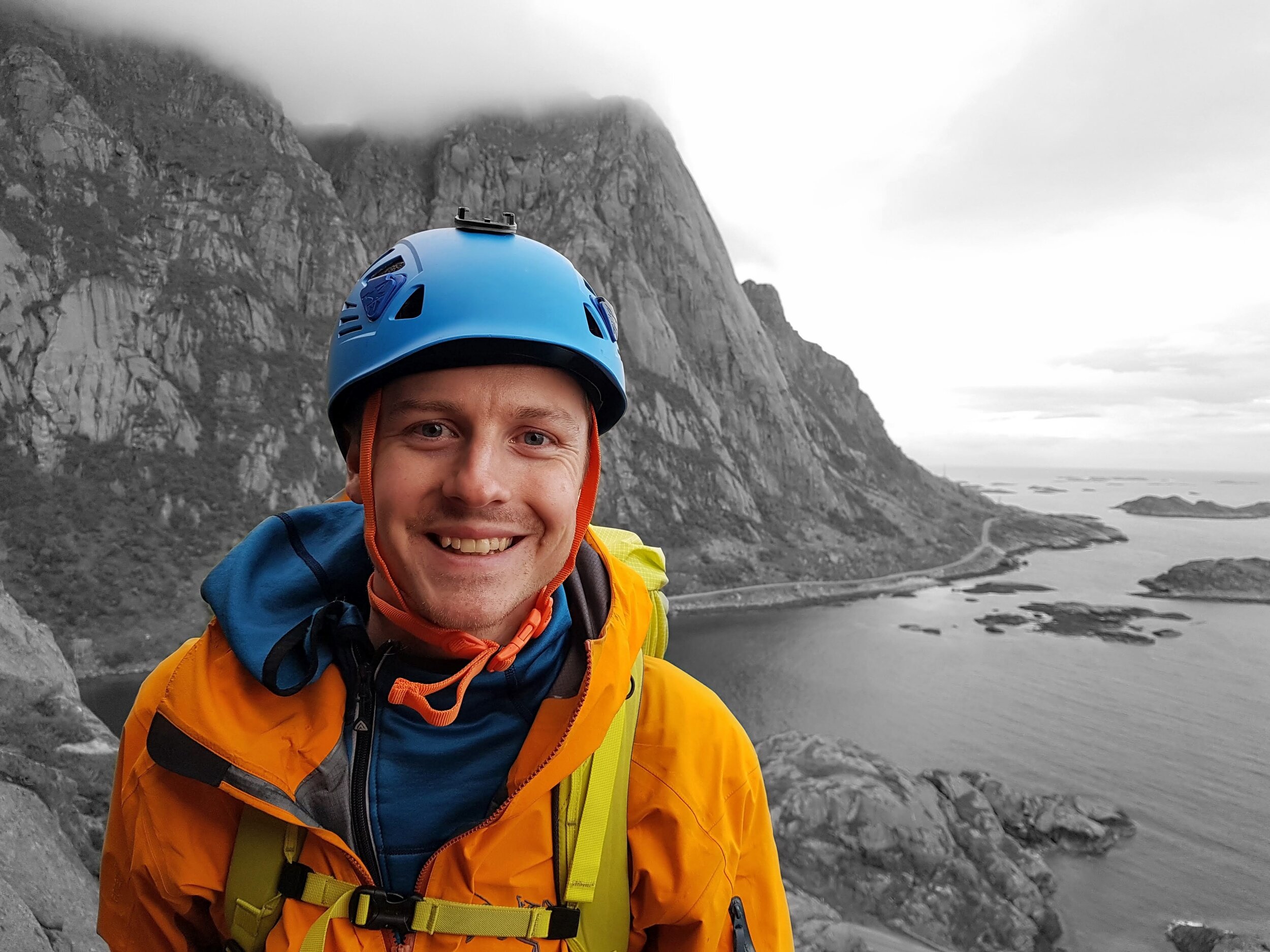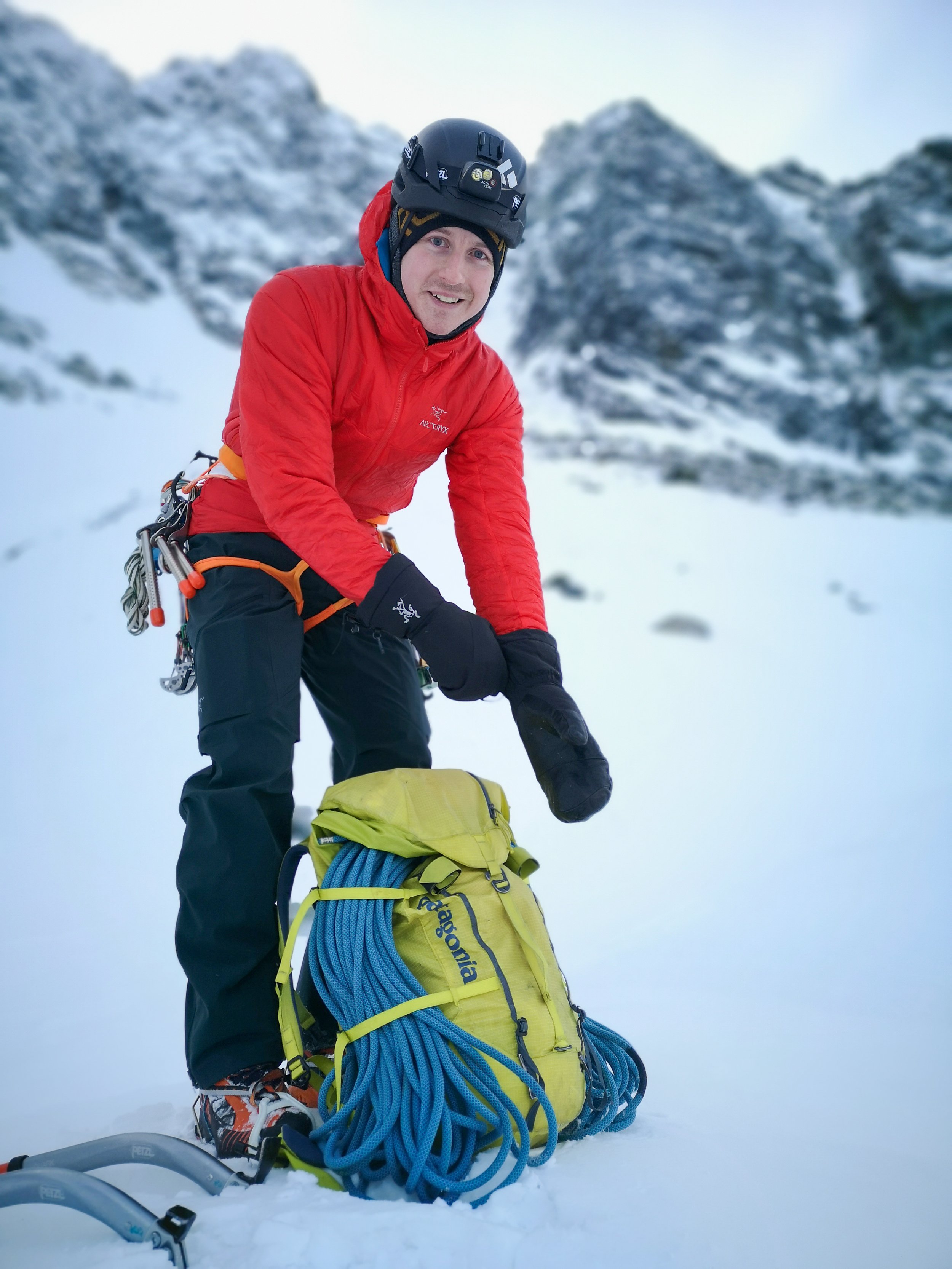Arcteryx Nuclei FL jacket review
I have previously written about winter layering systems, and I figured it was about time I write a review of this jacket since it has accompanied me on a LOT of trips since I got in in September 2020. A year later it has been with me on climbing, mountaineering, snowboarding, ice climbing, hiking, and even city adventures. I do feel like I’ve got a pretty good idea of the usefulness of this jacket in different situations.
I’ve started with my favourite uses of the jacket in summer and winter, then covered some of the usual features of this kind of jacket including warmth-to-weight ratio, compressibility, durability, form/function, and what the jacket is not made for. Hope you find the review useful, and please let me know in the comments if you have anything to add, questions or suggestions for more gear to review!
Keeping warm at the top of Baugen, Kvaløya. Photo: Dave Thornley.
Layers layers layers needed for cold missions in southern Lyngen. Photo: Kristoffer Forsberg Olsen.
Favourite uses in Winter:
Ice climbing: especially on very cold or windy days this jacket can keep me warm and still allow the full range of movement that ice climbing requires.
Ski/Mountaineering: as a summit jacket, usually putting it on around 30m before approaching a summit or ridge in anticipation of hanging around for a bit in the cold and wind. On cold days where I’m riding straight from the peak to the car (i.e. no long traverse or ascent back out) I’ll keep the jacket on, even as a top layer.
Favourite uses in Summer:
Climbing: as a belay jacket, descent jacket, or emergency layer stored in the pack for when it gets cold/windy.
Hiking: as a standalone outer layer or emergency layer.
Alpine climbing: that requires a light pack and frequent putting on/taking off an extra layer.
Warmth to weight ratio: I’ve been very impressed with how much warmth this layer can provide at such a low weight (Mens medium: 325g). I usually run cold, which is not ideal when most of my main activities involve frozen water in some shape or form, but with the jacket being so light I don’t hesitate to throw it in the bag if I’m even slightly unsure of the temperature/pace of the trip. It also acts as a great wind-barrier on windy days/ridges/belay stances, and I often wear it over the top of my shell at the summit.
Compressibility: Another big plus is the compressibility – the jacket compresses down to the size of a large water bottle if needed, although I rarely do that, preferring to just stuff it into my bag to fill the space. Since the insulating material is synthetic Coreloft instead of down, I feel more comfortable stuffing it away or in a bag for extended periods without impacting the warmth of the jacket through material compression. The stuff sack is fixed to the inner pocket too, so I haven’t lost it yet! I also often use it packed away into the stuff sack as a supplementary pillow while camping.
Durability: Sometimes with this sort of fabric, tears occur quickly and frequently, and it’s only a matter of time before you have to patch it up. This is completely anecdotal evidence of course, but the fabric seems to have been through a lot without tearing so far, including: falling (+scraping) down a granite slab for over 6m while climbing in Ersfjord; sliding face-down over a rough patch of ice on the way back from a mountain in Lyngen; climbing the last pitch of Baugen (including some chimney action); many other splitboard, ice climbing, rock climbing, and hiking trips since Autumn last year. Now, I’m not saying that the jacket is made to be particularly robust (it’s still super lightweight and thin fabric), but just that I have been pleasantly surprised at how much it’s been through without any signs of wear.
Form/function: The long and loose-fitting arms (in Mens medium for me) mean that arm mobility is never an issue while wearing the jacket to climb in, and I am able to wear it over the top of shell layers for a quickly added layer on and off for time spent at mountain peaks. One thing I do wish it had is a chest pocket, which I find really useful for mountaineering, etc. to store my phone or other items in for quick access when wearing a harness. It does have two large inner pockets which are great for glove storage though.
What it is not made for: Fast-paced adventures where a lot of heat and moisture are generated. The material is not very breathable, and can become wet if worn underneath a GoreTex shell on fast-ascents or on the way down (e.g. skiing/splitboarding). The good news is that it keeps you warm even when wet, but I’d for sure try to avoid it if possible. I have opened up my shell jacket at the end of more strenuous snowboard runs to find a lot of moisture build-up on the inside…so I’d suggest it’s better to use something more breathable for an all-day, active mid-layer and keep this as a summit jacket or lightweight extra layer on such trips. The jacket is at least super light, so it’s well-worth carrying with you on fast-paced activities even if its just used for the summit, snack break, or in an emergency.
Overall impressions:
This jacket is a great addition to your regular mountain apparel, and excels as a standalone outer-layer in cool/windy conditions, lightweight summit jacket over the top of your shell, and additional/emergency layer in the pack for when the weather gets rough. Low breathability limits its use as an all-day insulator for fast-paced activities, but being so packable and super low weight means its easy to keep in the pack or take on/off throughout the day as the conditions require.
That’s all I have for now! Please get in touch via the comments if you have anything to add, or recommendations for future gear reviews, I’d be happy for suggestions!
Note: This jacket was provided by Arc’teryx as sponsored gear, but the review is not influenced – just an excited mountaineers rambling on a good jacket!
This winter I’ll be testing the Atomic Backland Ultimate boots for splitboarding as a follow up to my review of the Backland Carbons over the last few years. Follow along on instagram or YouTube or check out my mountain tales blog if you want more mountain content!







